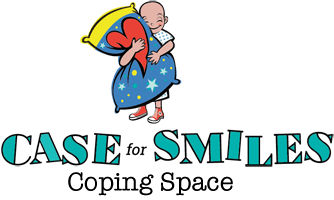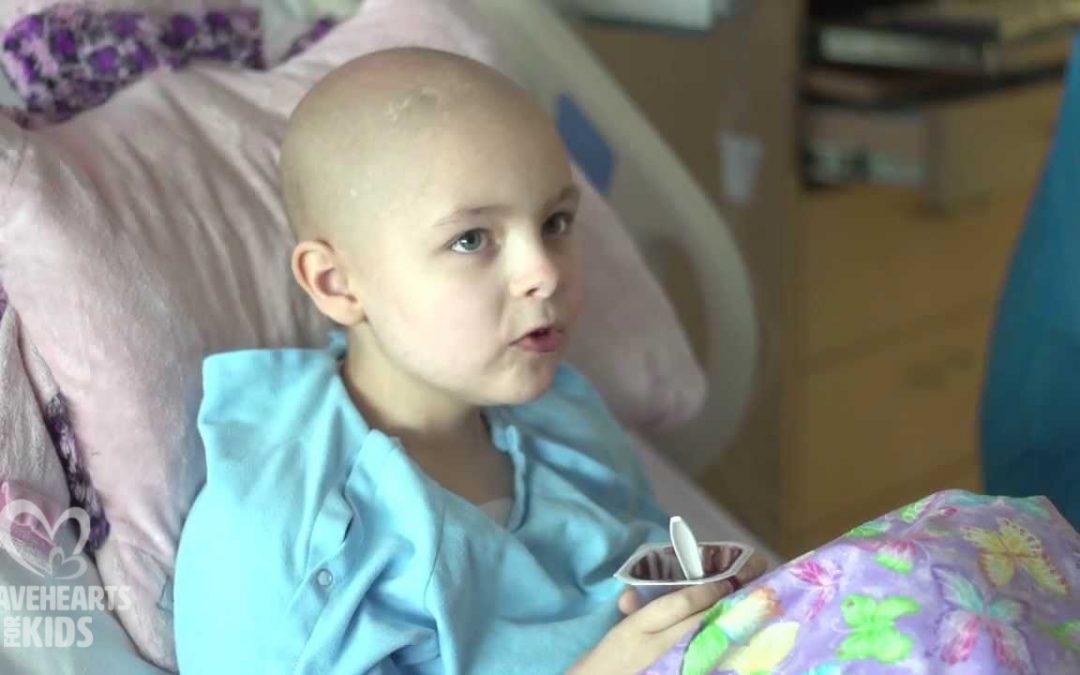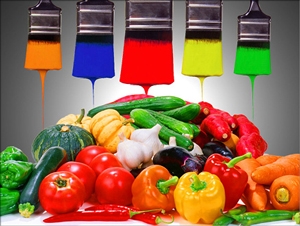
Creating Healing Spaces to Cope
By Cindy Kerr, Founder and CEO, Case for Smiles
15 years ago, I heard the words that every parent fears – “Your son has bone cancer.” I was numb, I was shocked and couldn’t believe that my 12-year-old son, Ryan was ill.
That was the beginning of a 6-year roller coaster ride for Ryan. We experienced it all – the months and months of chemotherapy, 15 surgeries, and the never-ending anxiety over upcoming CT scans.
As a mom, I felt so helpless when Ryan was first diagnosed. How could this happen to my son? Why couldn’t I protect him from all of this? There was little I could do to make him better. All I could do was love him.
My Journey
After the immediate shock of Ryan’s diagnosis, I did what moms do everywhere – I pulled myself together and took care of my family. Sure, the anxiety, fear, and terror were there, but I pushed it down and built a new normal for my family and myself.
There were lots of scary moments – the surgeries, the CT scans, the recurrences and many tough decisions – but through it all, I kept going, and so did my kids and husband.
We thought we were doing well. We felt other families needed the limited support resources more than ours. We were wrong.
Every day of our journey was a challenge. Caring for Ryan, trying to make sure my teenage daughters were ok, worrying about my husband and, on occasion, myself. Everything in our lives was turned upside down yet we still were functioning.
If only Ryan could survive, we would be ok, I thought. What I did not understand was the cumulative toll of the stress that was building each day. I learned that a child’s illness could leave lasting scars.
During Ryan’s illness, and since his death, every member of our family has felt the impact of pediatric medical traumatic stress (PMTS). Our oldest daughter lives in fear of every ache and pain, our younger daughter struggles with anxiety and my husband relives the most stressful experiences over and over. And me? I am always waiting for the next shoe to drop.
We learned we are not alone. Serious childhood illnesses and injuries can be terrifying experiences for children and their families- 20% of young children, 49% of adolescents, and over 30% of mother’s experience moderate to severe symptoms of post-traumatic stress disorder (PTSD).
Learning to Cope
My healing process has been lengthy and ongoing. I won’t lie to you and tell you there is some cure – one that will take away all the pain and stress. But what I learned through the years is that there are ways to minimize the impact of a child’s illness on you and your family.
That’s why I founded Case for Smiles and created Coping Space: an online resource and support site offering coping strategies and tips related to a child’s life-changing illness. It is designed to help you and your family cope, build resilience and restore balance.
Here are a few simple things I learned about coping and creating healing space for myself and my family.
#1 Set Up a Routine to Simplify Life
Keep the same morning routine and breakfast time, whenever possible – this makes starting the day more comfortable. Setting up a family check-in routine – this can happen in the morning to help plan the day, or at any time that works for your family, is also helpful.
When setting up routines, don’t forget about playtime! Setting aside a set time for your child and family to have fun is critical. Playing your favorite games, reading, drawing, or watching movies are all great ways to have fun!
Just like the morning routine, keep to the same night routine – Have a dinner and bedtime routine to help everyone relax at the end of the day. Dinnertime can be an excellent way to talk about what happened during the day.
Don’t forget to schedule time for yourself! Set time to check in with yourself each day. Take time to breathe, relax, and think about what is going well in your life at the moment.
#2 Become Mindful of Your Fears and Stress Triggers
Throughout my day, there are times when I experience anxiety due to the traumatic events from Ryan’s illness many years ago. I worry about my two daughters when I don’t hear from them regularly. If my husband is late getting in, sometimes I panic. Remember, everyone reacts differently, so you may or may not experience all the signs or symptoms of posttraumatic stress. Or you may or may not experience all at the same time. Being aware can help you take care of yourself and seek professional help if needed.
Symptoms of posttraumatic stress include:
- Reliving events connected to the diagnosis (also called re-experiencing). Example: “To this day, I can’t stand the antiseptic smell of hospitals.”
- Staying away from reminders of the illness (also called avoidance). Example: “I block it out and try not to think about when I was in the hospital.”
- Feeling anxious, jumpy, or being “on-guard,” also called hyper-arousal. Example: “I know that doctors say we’re in the clear, but I take my daughter’s temperature every day. I am always afraid something bad will happen.”
- Having strong negative thoughts and emotions (fear, guilt, blame, anger, sadness, confusion) or have trouble feeling positive emotions. Example: “If only I hadn’t done X or Y, I wouldn’t have gotten sick.”
- Experiencing other symptoms, such as developing new fears, feeling “spacey”, empty or numb. Example: “Ever since my son was in the hospital, he is terrified to be left alone- he never used to be like that.”
I have found that if I can identify situations that I know will be stressful to me ahead of time, I can cope better.
#3 Don’t be afraid to ask for help
Let’s face it: no one can do it all or do it alone. Family and friends want to help and there is no shame in reaching out. For many, there is a stigma about seeking out professional help.
Take advantage of the many people who can help you and your family. Reach out to a Social Worker, Pastor, Counselor, Psychologist or Psychiatrist. There is nothing wrong with getting help including appropriate medication prescribed by your doctor. The only shame is allowing yourself to suffer when there are people ready and able to help.
There is no time limit to the trauma that comes from dealing with a child’s illness. If you are suffering, I know your journey is incredibly hard. Developing coping skills won’t necessarily make the road ahead any easier but doing so can help you manage the stress.
I am living proof that you can survive this, perhaps a bit sadder but also wiser, stronger and more resilient. I hope you will visit our new Coping Space website designed to make the journey better for you and your family.





 Just because a food is white, doesn’t mean that it isn’t nutritious. In fact, white foods such as low-fat (1%) or fat-free milk, yogurt, and some cheeses are packed with vitamin D, calcium, and phosphorus.
Just because a food is white, doesn’t mean that it isn’t nutritious. In fact, white foods such as low-fat (1%) or fat-free milk, yogurt, and some cheeses are packed with vitamin D, calcium, and phosphorus. The natural plant pigment chlorophyll colours green fruits and vegetables. In our system, the green foods represented those foods rich in isothiocyanates, which induce enzymes in the liver that assist the body in removing potentially carcinogenic compounds.
The natural plant pigment chlorophyll colours green fruits and vegetables. In our system, the green foods represented those foods rich in isothiocyanates, which induce enzymes in the liver that assist the body in removing potentially carcinogenic compounds. A variation of the green colour category, these foods exhibit a richness in lutein, which is particularly beneficial for eye health. They also contain a high amount of vitamin C.
A variation of the green colour category, these foods exhibit a richness in lutein, which is particularly beneficial for eye health. They also contain a high amount of vitamin C. Orange foods are rich in beta-carotene, which are particularly good antioxidants. They are good for the heart, protect our eyes and also boost our immune system.
Orange foods are rich in beta-carotene, which are particularly good antioxidants. They are good for the heart, protect our eyes and also boost our immune system. Lycopene is the predominant pigment in reddish fruits and veggies. A carotenoid, lycopene is a powerful antioxidant that has been associated with a reduced risk of some cancers, especially prostate cancer, and protection against heart attacks.
Lycopene is the predominant pigment in reddish fruits and veggies. A carotenoid, lycopene is a powerful antioxidant that has been associated with a reduced risk of some cancers, especially prostate cancer, and protection against heart attacks. The blue/purple hues in foods are due primarily to their anthocyanin content; the darker the blue hue, the higher the phytochemical concentration. Blueberries are considered to have the highest antioxidant activity of all foods.
The blue/purple hues in foods are due primarily to their anthocyanin content; the darker the blue hue, the higher the phytochemical concentration. Blueberries are considered to have the highest antioxidant activity of all foods.





Most Commented